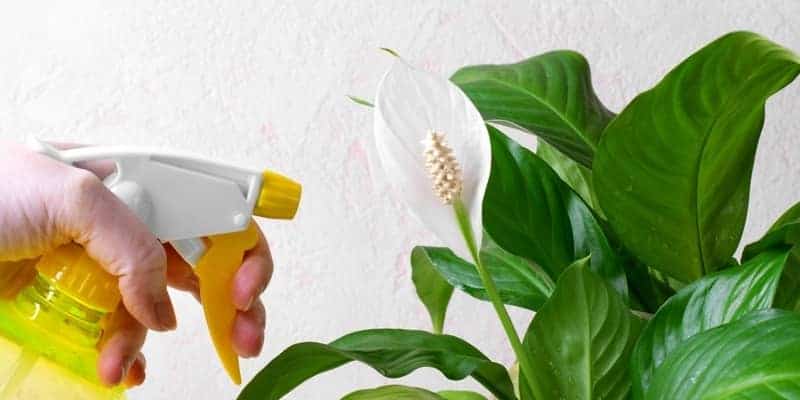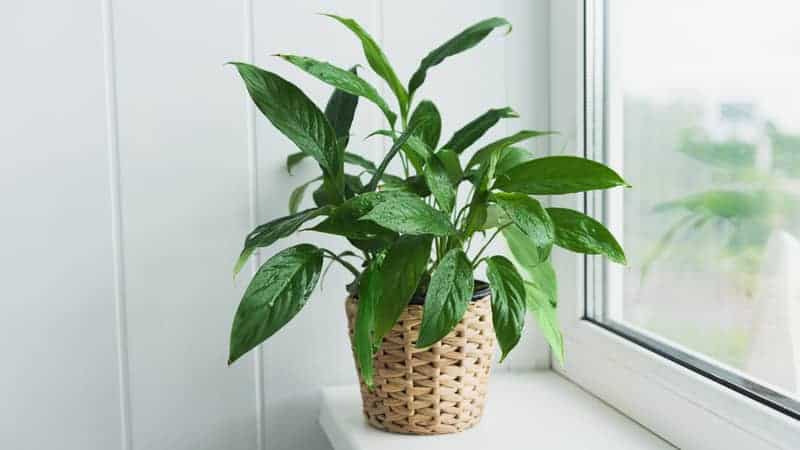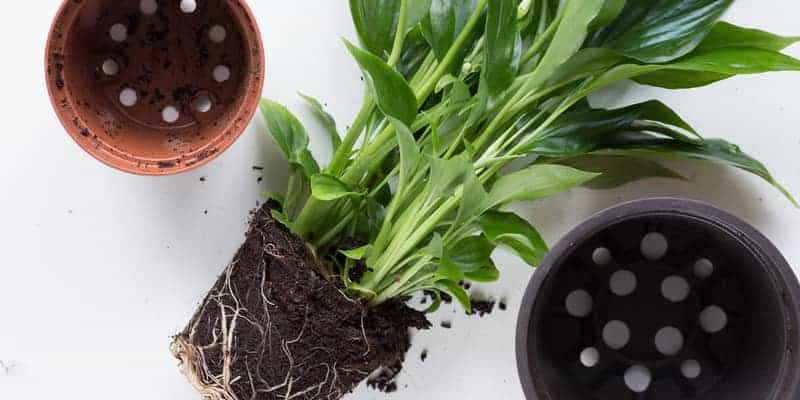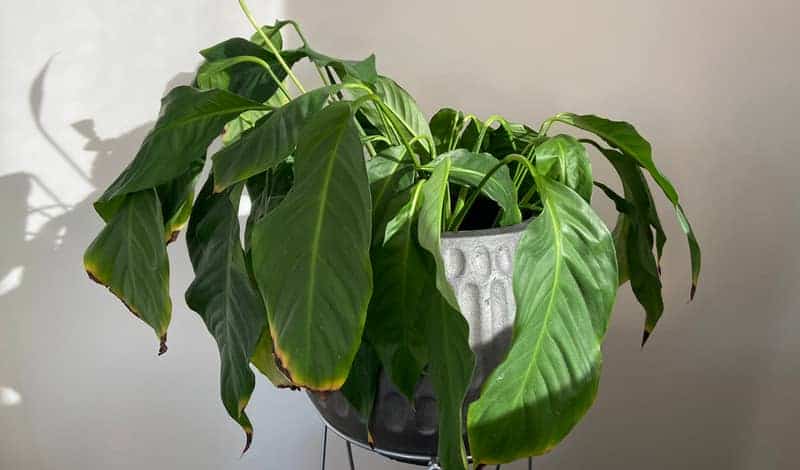Peace lilies are beautiful and popular houseplants that can add style and freshness to any room. They are relatively easy to care for and can be a great addition to your indoor garden.
However, keeping them healthy and thriving requires some specific care and attention.
Choosing a Peace Lily Variety
Consider the size of your space
Before you select a peace lily variety, it’s important to consider the size of your space and the amount of light it receives.
A tabletop peace lily might be the perfect fit if you have a small apartment or office. But if you have a larger space with lots of natural light, get a larger peace lily that can really make a statement.
Look at the foliage

While the white flowers are what the peace lily is most famous for, don’t overlook the foliage. Take a close look at the foliage of the peace lily you’re considering to make sure it’s healthy and vibrant.
Peace lilies come in different shades of green, and some varieties have variegated leaves with white or yellow stripes.
Think about your plant care style
If you’re new to plant care, look for a variety that is easy to care for. The peace lily is already a relatively low-maintenance plant, but some varieties require less water and attention than others.
If you’re a home gardening expert and enjoy caring for your plants, consider a peace lily that requires a bit more attention.
How to Grow and Care for a Peace Lily Indoors
In need of some tips to grow a healthy peace lily plant? Here’s the full rundown!
Water

Peace lilies prefer moist soil rather than soggy or dry soil. Allow the top inch of the soil to dry out between waterings.
Remember to water your peace lily with filtered water at room temperature to prevent shocking the plant. Make sure to empty the excess water from the pot saucer to avoid overwatering.
It’s also worth knowing that peace lilies grow best in a humid environment.
You can increase the humidity in the room by placing a tray of water near your plant or by regularly misting its leaves with a water-filled spray bottle.
Light

Most peace lilies prefer moderate to bright indirect light, but some are more tolerant of low light conditions. Avoid placing them in direct sunlight, as it may scorch the leaves.
Instead, place them near a window that gets plenty of natural light. You can also place them under fluorescent lights if your room doesn’t get adequate sunlight.
Soil and fertiliser
The best potting mix for a peace lily is well-draining soil mix that keeps moisture without becoming waterlogged.
A mix of peat moss, perlite, and vermiculite can be an excellent choice. You can also mix in some organic compost for added nutrients.
While peace lilies do not require much fertiliser, supplying them some once every six months will help them thrive. Use a balanced, water-soluble fertiliser, and apply it to the soil.
You can also help your peace lily develop healthy, green leaves by fertilising it once a month during the summer growing season.
Temperature and airflow
Peace lilies prefer a warm, consistent temperature between 20°C and 30°C. Avoid placing them in cold temperatures or near drafts, air conditioning vents or radiators, as it may damage the leaves.
Good airflow is essential to prevent bacterial and fungal diseases, so ensure the room has a good ventilation system.
Pruning and repotting

Regular pruning can help keep your peace lily looking healthy and promote new growth. Remove any wilted or yellow leaves, as they can drain the plant’s energy.
You can also remove any dead or dying flowers turning green or brown to encourage new blooms.
Repotting your peace lily is essential every 1-2 years using fresh soil to ensure the plant has enough space to grow.
Common Problems With Peace Lilies
Although peace lilies are easy to care for overall, they can still have some complications.
Pests
Like any indoor plant, peace lilies can fall prey to pests. Look out for fungus gnats, spider mites, mealybugs and common plant scale.
To deal with pests, try wiping down the plant’s leaves with a damp cloth or using insecticidal soap or neem oil.
If your plant is heavily infested, you may need to isolate the entire plant and spray it with an insecticide.
Brown leaf tips
If you notice the tips of your peace lily’s leaves turning brown and crispy, it’s likely due to either overwatering or underwatering. To figure out which one may be the issue, touch the soil.
If it’s dry, your plant is thirsty and may need more water to drink. If the soil is moist, you’ve likely been too generous with your watering can. Check the pot’s drainage holes and adjust your watering schedule.
Yellow leaves
Some peace lilies have bright, light green leaves. But if you see yellow leaves, it could be a sign of nutrient deficiency.
Try fertilising your plant with a balanced, water-soluble fertiliser once or twice a month.
Alternatively, it could be a symptom of overwatering. As with browning leaves, feel the soil to see if it’s dry or moist – if it’s the latter, back off on the watering.
Drooping peace lily leaves

Peace lilies are notorious for being drama queens, so it could be something as simple as too much or too little water. Or maybe it’s not getting enough light, or it’s in a spot that’s too hot or too cold.
Your peace lily may also droop after repotting it.
Keep in mind that plants can’t talk (as much as we’d love them to), so it’s up to us to play detective and figure out what they need.
Just give your peace lily a little more or a little less love and watch her bounce back to her gorgeous, leafy self in no time.
Root rot
Overwatering your peace lily can lead to root rot, which can cause the plant to die. Signs of root rot include black or brown roots, yellowing leaves, and a foul smell.
Place your peace lily in a well-draining potting mix and water according to a moisture meter’s readings to prevent root rot.
If you suspect root rot, uproot the plant, and trim the dark brown or blacked roots before replanting in fresh soil.
Peace Lily FAQs
Can peace lilies be grown in water?
Absolutely! Peace lilies can easily be grown in water. In fact, they might even prefer it.
All you need to do is submerge the peace lily plant’s roots in water and watch it grow.
Are peace lilies toxic to cats and dogs?
Unfortunately, peace lilies are toxic to cats and dogs if ingested. But don’t worry, that doesn’t mean you have to get rid of your beloved plant.
Of course, prevention is always better than cure, so it’s best to keep these plants out of reach or opt for pet-friendly plants if you have curious critters roaming around.
Do peace lilies need sun or shade?
Peace lilies can thrive in both sunny and shaded environments. However, peace lilies tend to grow healthier in indirect bright sunlight.
This is a particularly important decision when selecting where to grow a peace lily outdoors.

